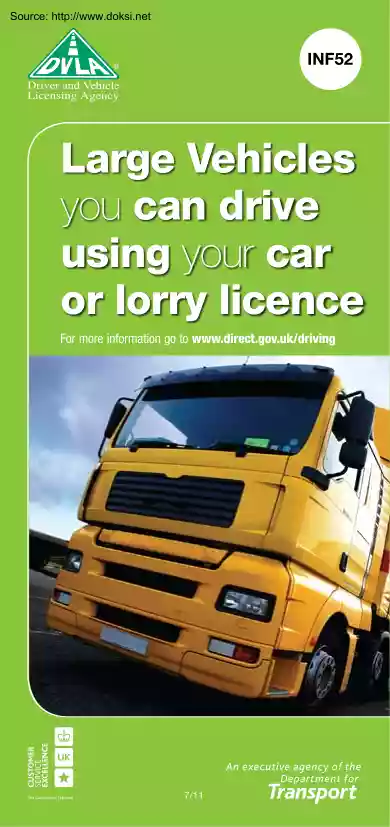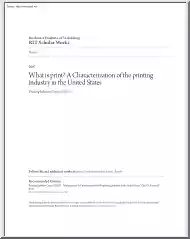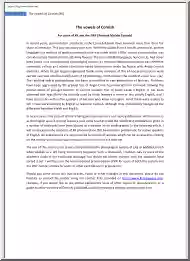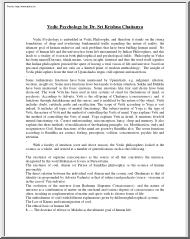Értékelések
Nincs még értékelés. Legyél Te az első!
Mit olvastak a többiek, ha ezzel végeztek?
Tartalmi kivonat
Source: http://www.doksinet INF52 Large Vehicles you can drive using your car or lorry licence For more information go to www.directgovuk/driving 7/11 Source: http://www.doksinet Contents Information leaflets. 2 Goods vehicles that can be driven with a full category B licence. 3 Buses that can be driven with a full category B licence. 5 Buses that can be driven with a full category C licence . 5 Minimum ages. 6 Descriptions of vehicle categories. 6 How are vehicles classed?. 8 Important information, please read carefully This leaflet explains that you can drive large vehicles or buses using your lorry (LGV) or car driving licence. Please note: All professional bus, coach and lorry drivers must hold a driver Certificate of Professional Competence (CPC) as well as their vocational driving licence. For more advice, phone the Driving Standards Agency on 0300 200 1122 or send an email to drivercpc@dsa.gsigovuk Information leaflets We produce other leaflets dealing with minibuses,
trailers, MoTs and heavy goods vehicle tests, and driving in GB as a visitor or new resident. You can download these from the website at www.directgovuk/motoringleaflets or order copies by phoning 0300 790 6801. 19249 2 Source: http://www.doksinet Goods vehicles that can be driven with a full category B licence If you hold a full category B driving licence you can drive any of the following large vehicles, known as ‘exempted’ goods vehicles. • Goods vehicles powered by steam (for example, large vehicles with coal or wood-burning engines). • Any road construction vehicles used or kept on the road for carrying built-in road construction machinery (with or without the materials used by that machinery). • Any engineering equipment (vehicles designed or built for the purpose of engineering work), except mobile cranes. • A works truck designed for use on private property or in the immediate area around it (for example, trucks and forklift trucks). • Industrial tractors
(tractors used mainly for haulage work off the public road) with a weight of no more than 7370kg when loaded, and designed to travel no faster than 20mph. • Agricultural motor vehicles which are used off the road and are not tractors (for example, crop sprayers and combine harvesters). • Digging machines (vehicles with digging buckets or shovels) which travel on a public road only for the purpose of going to or from a site where they are used for digging or shovelling work. • Goods vehicles which are: - used on the public road only to move between land owned or used by the person keeping the vehicle, and - not used on public roads for distances of more than 9.7 kilometres in total during any week (midnight on Saturday to midnight on the following Saturday). • Goods vehicles, other than agricultural motor vehicles, which: - are used only for agriculture, horticulture or forestry purposes - are used on roads only to move between land owned or used by the keeper of the vehicle,
and - do not travel more than 1.5 kilometres on roads at one time. • Goods vehicles used for no purpose other than moving lifeboats and the necessary gear of the lifeboats. • Goods vehicles built before 1 January 1960, as long as they are not loaded and are not towing a loaded trailer. • Articulated goods vehicles weighing less than 3.05 tonnes when not loaded. 3 Source: http://www.doksinet • Goods vehicles being used by a visiting armed force or headquarters (as defined in the Visiting Forces and International Headquarters (Application of Law) Order 1965(a)). • Goods vehicles driven by a police officer for the purpose of: - stopping the vehicle obstructing road users or other members of the public, or - protecting life or property (including the vehicle and its load), or for similar purposes. • Goods vehicles fitted with equipment designed for partly raising a broken-down or disabled vehicle (one that cannot be driven) from the ground and towing it, as long as the goods
vehicles: - are only used for dealing with broken-down or disabled vehicles - are not used for carrying any goods other than broken-down or disabled vehicles and items needed to deal with broken-down or disabled vehicles, and - weigh no more than 3.05 tonnes when not loaded • A bus recovery vehicle. A bus recovery vehicle is a vehicle (not being an articulated goods vehicle) which: - has an unloaded weight of no more than 10.2 tonnes - is being driven by the holder of a PSV operator’s licence, and - is being used for the purpose of: - going to, or returning from, a place where help will or has been given to a damaged or broken-down bus, or - trying to repair or moving a broken-down bus, or moving a damaged vehicle. Note: Bus recovery vehicles can also be driven with full category D entitlement. • Mobile project vehicles. A vehicle which has a Maximum Authorised Mass (MAM) exceeding 3.5 tonnes, whose primary purpose is to be used as a recreational, educational or instructional
facility when stationary, carrying: - mainly goods or burden consisting of play or educational equipment and articles required in connection with the use of such equipment, or - articles required for the purpose of display or of an exhibition. The vehicle must be constructed or adapted to carry not more than eight persons in addition to the driver. 4 Source: http://www.doksinet You must be aged 21 and have held a category B licence for at least two years. A mobile project vehicle may only be driven on behalf of a non-commercial organisation. If a driver passes a (category B) car test before 1 January 1997 they may be able to drive the vehicle commercially. Mobile cranes Since 1 January 1999, a category C1 driving licence is needed to drive a mobile crane which weighs between 3.5 tonnes and 75 tonnes, and category C if the crane weighs over 7.5 tonnes Buses that can be driven with a full category B licence If you hold a full category B driving licence you can drive any of the
following vehicles (known as exempted passenger-carrying vehicles). • A bus made more than 30 years before the date it is being driven, and not used for business purposes or for carrying more than eight passengers. • A minibus with up to 16 passenger seats, as long as: - the vehicle is used for social purposes by a non-commercial organisation, but not for hire or reward (that is, not to make a profit) - the driver is at least 21 - the driver has held a car (category B) licence for at least two years - the driver has volunteered to drive - the maximum weight of the minibus is not more than 3.5 tonnes (or 425 tonnes including any specialist equipment for carrying disabled passengers), and - if the driver is 70 or over, he or she can meet the health standards for driving a minibus (category D1). Buses that can be driven with a full category C licence If you hold a full category C (LGV) driving licence you can also drive large buses as long as you have held the licence for at least
two years and the vehicle is: • damaged or faulty and being driven to a place to be repaired, or is being road-tested after repair, and • is not used for carrying any person who is not connected with repairing or road-testing it. 5 Source: http://www.doksinet Minimum ages The minimum age for driving an exempted goods vehicle depends on its weight. • Vehicles with a MAM of more than 3.5 tonnes but less than 7.5 tonnes may be driven from the age of 18 • Vehicles which weigh more than 7.5 tonnes can be driven from the age of 21. • The minimum age for driving an exempted passenger-carrying vehicle is 18. Descriptions of vehicle categories Category B Description Cars Minimum age Notes that apply 17 Motor vehicles with a MAM of up to 3,500kg, no more than eight passenger seats, with or without a trailer weighing up to 750kg. If the car is with a trailer weighing more than 750kg, the total weight of the vehicle and the trailer together can’t be more than 3,500kg. The
weight of the trailer, when fully loaded, can’t weigh more than the weight of the vehicle when it is not loaded and has no passengers. C1 Medium sized vehicles 18 Note 4 21 Note 1 21 Notes 2 and 4 21 Notes 2 and 3 Vehicles weighing between 3,500kg and 7,500kg, with or without a trailer weighing up to 750kg. C Large vehicles Vehicles over 3,500kg with a trailer weighing up to 750kg. D1 Minibuses Vehicles with 9 to 16 passenger seats, with or without a trailer weighing up to 750kg. D Buses Any bus with more than eight passenger seats, with a trailer up to 750kg. 6 Source: http://www.doksinet Note 1 You can drive at 17 if you are a member of the armed services. You can drive at 18 if: • you have passed your driving test and Driver CPC initial qualification • you are learning to drive or taking a driving test for this category or the Driver CPC initial qualification • you are taking a national vocational training course to get the Driver CPC initial
qualification, or • you got your driving licence before 10 September 2009 (in which case you must take the CPC periodic training within five years of the date you got your driving licence). Note 2 You can drive at age 17 if you are a member of the armed services. You can drive these vehicles at age 18 if one of the following apply: i) You are learning to drive or taking a PCV test or Driver CPC initial qualification. ii) Having passed a PCV driving test and Driver CPC initial qualification, you can drive under any of the following conditions: • driving on a regular service where the route doesn’t exceed 50km • not engaged in the carriage of passengers, or • driving a vehicle of a class included in sub-category D1. iii) Having passed a PCV test before 10 September 2008 and driving under a bus operator’s licence, or minibus permit, or community bus permit and any of the following conditions: • driving on a regular service where the route doesn’t exceed 50km • not
engaged in the carriage of passengers, or • driving a vehicle of a class included in sub-category D1. You can drive at age 20 after passing a PCV driving test and Driver CPC initial qualification. For further advice you can contact the Driving Standards Agency by phoning 0300 200 1122 or by email at drivercpc@dsa.gsigovuk Note 3 You need category D entitlement to drive an articulated bus (for example, a ‘bendibus’). If you require more information see contact details below. Note 4 If you passed your test for category B or B automatic before 1 January 1997, your licence will already show entitlements C1, C1E (8.25 tonnes), D1 and D1E (not for hire or reward) 7 Source: http://www.doksinet How are vehicles classed? We cannot give legal advice on how vehicles are classed for driving licence purposes. The Technology and Standards Division of the Department for Transport may be able to help you work out whether a vehicle is classified as a works truck, an agricultural motor
vehicle, an industrial tractor or engineering equipment, but only for the purposes of how it is built and used. You can contact them at: Great Minster House 76 Marsham Street London SW1P 4DR. Phone 0207 944 8300 You should get independent legal advice if necessary. If you have any questions Phone Customer Enquiries on 0300 790 6801. The lines are open between 8am and 7pm Monday to Friday, and between 8am and 2pm on Saturdays. Email go to: www.directgovuk/emaildvla Fax (from the UK): 0300 123 0784 Fax (from abroad): +44 1792 786369 Textphone: 0300 123 1278 If you change your name, address or vehicle, please tell us immediately. If you don’t you could be fined £1000 8
trailers, MoTs and heavy goods vehicle tests, and driving in GB as a visitor or new resident. You can download these from the website at www.directgovuk/motoringleaflets or order copies by phoning 0300 790 6801. 19249 2 Source: http://www.doksinet Goods vehicles that can be driven with a full category B licence If you hold a full category B driving licence you can drive any of the following large vehicles, known as ‘exempted’ goods vehicles. • Goods vehicles powered by steam (for example, large vehicles with coal or wood-burning engines). • Any road construction vehicles used or kept on the road for carrying built-in road construction machinery (with or without the materials used by that machinery). • Any engineering equipment (vehicles designed or built for the purpose of engineering work), except mobile cranes. • A works truck designed for use on private property or in the immediate area around it (for example, trucks and forklift trucks). • Industrial tractors
(tractors used mainly for haulage work off the public road) with a weight of no more than 7370kg when loaded, and designed to travel no faster than 20mph. • Agricultural motor vehicles which are used off the road and are not tractors (for example, crop sprayers and combine harvesters). • Digging machines (vehicles with digging buckets or shovels) which travel on a public road only for the purpose of going to or from a site where they are used for digging or shovelling work. • Goods vehicles which are: - used on the public road only to move between land owned or used by the person keeping the vehicle, and - not used on public roads for distances of more than 9.7 kilometres in total during any week (midnight on Saturday to midnight on the following Saturday). • Goods vehicles, other than agricultural motor vehicles, which: - are used only for agriculture, horticulture or forestry purposes - are used on roads only to move between land owned or used by the keeper of the vehicle,
and - do not travel more than 1.5 kilometres on roads at one time. • Goods vehicles used for no purpose other than moving lifeboats and the necessary gear of the lifeboats. • Goods vehicles built before 1 January 1960, as long as they are not loaded and are not towing a loaded trailer. • Articulated goods vehicles weighing less than 3.05 tonnes when not loaded. 3 Source: http://www.doksinet • Goods vehicles being used by a visiting armed force or headquarters (as defined in the Visiting Forces and International Headquarters (Application of Law) Order 1965(a)). • Goods vehicles driven by a police officer for the purpose of: - stopping the vehicle obstructing road users or other members of the public, or - protecting life or property (including the vehicle and its load), or for similar purposes. • Goods vehicles fitted with equipment designed for partly raising a broken-down or disabled vehicle (one that cannot be driven) from the ground and towing it, as long as the goods
vehicles: - are only used for dealing with broken-down or disabled vehicles - are not used for carrying any goods other than broken-down or disabled vehicles and items needed to deal with broken-down or disabled vehicles, and - weigh no more than 3.05 tonnes when not loaded • A bus recovery vehicle. A bus recovery vehicle is a vehicle (not being an articulated goods vehicle) which: - has an unloaded weight of no more than 10.2 tonnes - is being driven by the holder of a PSV operator’s licence, and - is being used for the purpose of: - going to, or returning from, a place where help will or has been given to a damaged or broken-down bus, or - trying to repair or moving a broken-down bus, or moving a damaged vehicle. Note: Bus recovery vehicles can also be driven with full category D entitlement. • Mobile project vehicles. A vehicle which has a Maximum Authorised Mass (MAM) exceeding 3.5 tonnes, whose primary purpose is to be used as a recreational, educational or instructional
facility when stationary, carrying: - mainly goods or burden consisting of play or educational equipment and articles required in connection with the use of such equipment, or - articles required for the purpose of display or of an exhibition. The vehicle must be constructed or adapted to carry not more than eight persons in addition to the driver. 4 Source: http://www.doksinet You must be aged 21 and have held a category B licence for at least two years. A mobile project vehicle may only be driven on behalf of a non-commercial organisation. If a driver passes a (category B) car test before 1 January 1997 they may be able to drive the vehicle commercially. Mobile cranes Since 1 January 1999, a category C1 driving licence is needed to drive a mobile crane which weighs between 3.5 tonnes and 75 tonnes, and category C if the crane weighs over 7.5 tonnes Buses that can be driven with a full category B licence If you hold a full category B driving licence you can drive any of the
following vehicles (known as exempted passenger-carrying vehicles). • A bus made more than 30 years before the date it is being driven, and not used for business purposes or for carrying more than eight passengers. • A minibus with up to 16 passenger seats, as long as: - the vehicle is used for social purposes by a non-commercial organisation, but not for hire or reward (that is, not to make a profit) - the driver is at least 21 - the driver has held a car (category B) licence for at least two years - the driver has volunteered to drive - the maximum weight of the minibus is not more than 3.5 tonnes (or 425 tonnes including any specialist equipment for carrying disabled passengers), and - if the driver is 70 or over, he or she can meet the health standards for driving a minibus (category D1). Buses that can be driven with a full category C licence If you hold a full category C (LGV) driving licence you can also drive large buses as long as you have held the licence for at least
two years and the vehicle is: • damaged or faulty and being driven to a place to be repaired, or is being road-tested after repair, and • is not used for carrying any person who is not connected with repairing or road-testing it. 5 Source: http://www.doksinet Minimum ages The minimum age for driving an exempted goods vehicle depends on its weight. • Vehicles with a MAM of more than 3.5 tonnes but less than 7.5 tonnes may be driven from the age of 18 • Vehicles which weigh more than 7.5 tonnes can be driven from the age of 21. • The minimum age for driving an exempted passenger-carrying vehicle is 18. Descriptions of vehicle categories Category B Description Cars Minimum age Notes that apply 17 Motor vehicles with a MAM of up to 3,500kg, no more than eight passenger seats, with or without a trailer weighing up to 750kg. If the car is with a trailer weighing more than 750kg, the total weight of the vehicle and the trailer together can’t be more than 3,500kg. The
weight of the trailer, when fully loaded, can’t weigh more than the weight of the vehicle when it is not loaded and has no passengers. C1 Medium sized vehicles 18 Note 4 21 Note 1 21 Notes 2 and 4 21 Notes 2 and 3 Vehicles weighing between 3,500kg and 7,500kg, with or without a trailer weighing up to 750kg. C Large vehicles Vehicles over 3,500kg with a trailer weighing up to 750kg. D1 Minibuses Vehicles with 9 to 16 passenger seats, with or without a trailer weighing up to 750kg. D Buses Any bus with more than eight passenger seats, with a trailer up to 750kg. 6 Source: http://www.doksinet Note 1 You can drive at 17 if you are a member of the armed services. You can drive at 18 if: • you have passed your driving test and Driver CPC initial qualification • you are learning to drive or taking a driving test for this category or the Driver CPC initial qualification • you are taking a national vocational training course to get the Driver CPC initial
qualification, or • you got your driving licence before 10 September 2009 (in which case you must take the CPC periodic training within five years of the date you got your driving licence). Note 2 You can drive at age 17 if you are a member of the armed services. You can drive these vehicles at age 18 if one of the following apply: i) You are learning to drive or taking a PCV test or Driver CPC initial qualification. ii) Having passed a PCV driving test and Driver CPC initial qualification, you can drive under any of the following conditions: • driving on a regular service where the route doesn’t exceed 50km • not engaged in the carriage of passengers, or • driving a vehicle of a class included in sub-category D1. iii) Having passed a PCV test before 10 September 2008 and driving under a bus operator’s licence, or minibus permit, or community bus permit and any of the following conditions: • driving on a regular service where the route doesn’t exceed 50km • not
engaged in the carriage of passengers, or • driving a vehicle of a class included in sub-category D1. You can drive at age 20 after passing a PCV driving test and Driver CPC initial qualification. For further advice you can contact the Driving Standards Agency by phoning 0300 200 1122 or by email at drivercpc@dsa.gsigovuk Note 3 You need category D entitlement to drive an articulated bus (for example, a ‘bendibus’). If you require more information see contact details below. Note 4 If you passed your test for category B or B automatic before 1 January 1997, your licence will already show entitlements C1, C1E (8.25 tonnes), D1 and D1E (not for hire or reward) 7 Source: http://www.doksinet How are vehicles classed? We cannot give legal advice on how vehicles are classed for driving licence purposes. The Technology and Standards Division of the Department for Transport may be able to help you work out whether a vehicle is classified as a works truck, an agricultural motor
vehicle, an industrial tractor or engineering equipment, but only for the purposes of how it is built and used. You can contact them at: Great Minster House 76 Marsham Street London SW1P 4DR. Phone 0207 944 8300 You should get independent legal advice if necessary. If you have any questions Phone Customer Enquiries on 0300 790 6801. The lines are open between 8am and 7pm Monday to Friday, and between 8am and 2pm on Saturdays. Email go to: www.directgovuk/emaildvla Fax (from the UK): 0300 123 0784 Fax (from abroad): +44 1792 786369 Textphone: 0300 123 1278 If you change your name, address or vehicle, please tell us immediately. If you don’t you could be fined £1000 8





 Írásunkban a műelemzések készítésének módszertanát járjuk körül. Foglalkozunk az elemzés főbb fajtáival, szempontjaival és tanácsokat adunk az elemzés legfontosabb tartalmi elemeivel kapcsolatban is. Módszertani útmutatónk főként tanulók számára készült!
Írásunkban a műelemzések készítésének módszertanát járjuk körül. Foglalkozunk az elemzés főbb fajtáival, szempontjaival és tanácsokat adunk az elemzés legfontosabb tartalmi elemeivel kapcsolatban is. Módszertani útmutatónk főként tanulók számára készült!